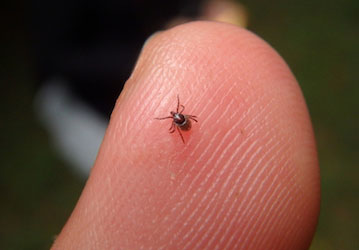 Ahhh, summer... While the extra time spent outside often brings fun memories, it also can mean a higher risk for tick bites, which can cause Lyme disease. Transmitted by blacklegged ticks (also called deer ticks), Lyme disease develops in only about 2% of people who are bitten by a tick. But the Centers for Disease Control and Prevention (CDC) estimates nearly 300,000 people in the United States are diagnosed with Lyme disease each year.
Ahhh, summer... While the extra time spent outside often brings fun memories, it also can mean a higher risk for tick bites, which can cause Lyme disease. Transmitted by blacklegged ticks (also called deer ticks), Lyme disease develops in only about 2% of people who are bitten by a tick. But the Centers for Disease Control and Prevention (CDC) estimates nearly 300,000 people in the United States are diagnosed with Lyme disease each year.
Lyme disease can be difficult to detect. Left untreated, it can lead to serious conditions, including facial paralysis, meningitis, arthritis, short-term memory loss, and heart problems. Service Members might be at an even higher risk for Lyme disease because of extra time spent outside for training activities and in areas where ticks are common. Whether you’re on active duty or just spending more time outside, prevention is key for both you and your family.
Know the risks
- Ticks can be found in almost any area outside but are most typically found in tall grasses and wooded areas.
- Ticks are most active in spring and summer when it’s warm outside.
- The highest numbers of reported Lyme disease cases in the United States occur in the Northeast and Midwest, so be extra careful if you’re in these areas.
- Pets often carry ticks in from outside. Even if you don’t spend much time outside, remember that your furry friends do!
- Deer ticks are very small, particularly before they are fully grown, so keep your eyes peeled to prevent infection.
Tips for prevention
- At home, keep your lawn mowed and your leaves raked.
- Spray your clothing and gear with 0.5% permethrin before going outside.
- Treat your body with insect repellents containing DEET, picaridin, IR3535, oil of lemon eucalyptus (OLE), para-menthane-diol (PMD), or 2-undecanone. (If you have kids, check to see which tick repellants are considered safe.)
- After you’ve been outside, take a shower, and wash and (tumble) dry your clothes.
- Do regular tick checks:
- Know what a deer tick looks like.
- Look over your clothing and your body (and your kid’s and pet’s bodies too) for any ticks that might be hitching a ride.
- Be sure and check your hair, behind your ears, the back of your neck, and in the bends of your joints where ticks tend to hide.
- Generally, ticks need to be attached for 36 to 48 hours before they can transmit the bacteria that causes Lyme disease, so daily tick checks are important.
- If you find a tick, remove it right away with fine-tipped tweezers!
- Check out the CDC website to learn more about ticks and Lyme disease.
When to seek help
Early signs of Lyme disease often include fever, chills, headaches, fatigue, and muscle or joint pain. But about 70% of people diagnosed report seeing a particular “bullseye” rash around the area of the tick bite. (The average time of rash onset is 7 days, but it can range from 3 to 30 days.) If you or a family member has been bitten by a tick or are concerned about symptoms, seek medical care as soon as possible to avoid serious illness.





